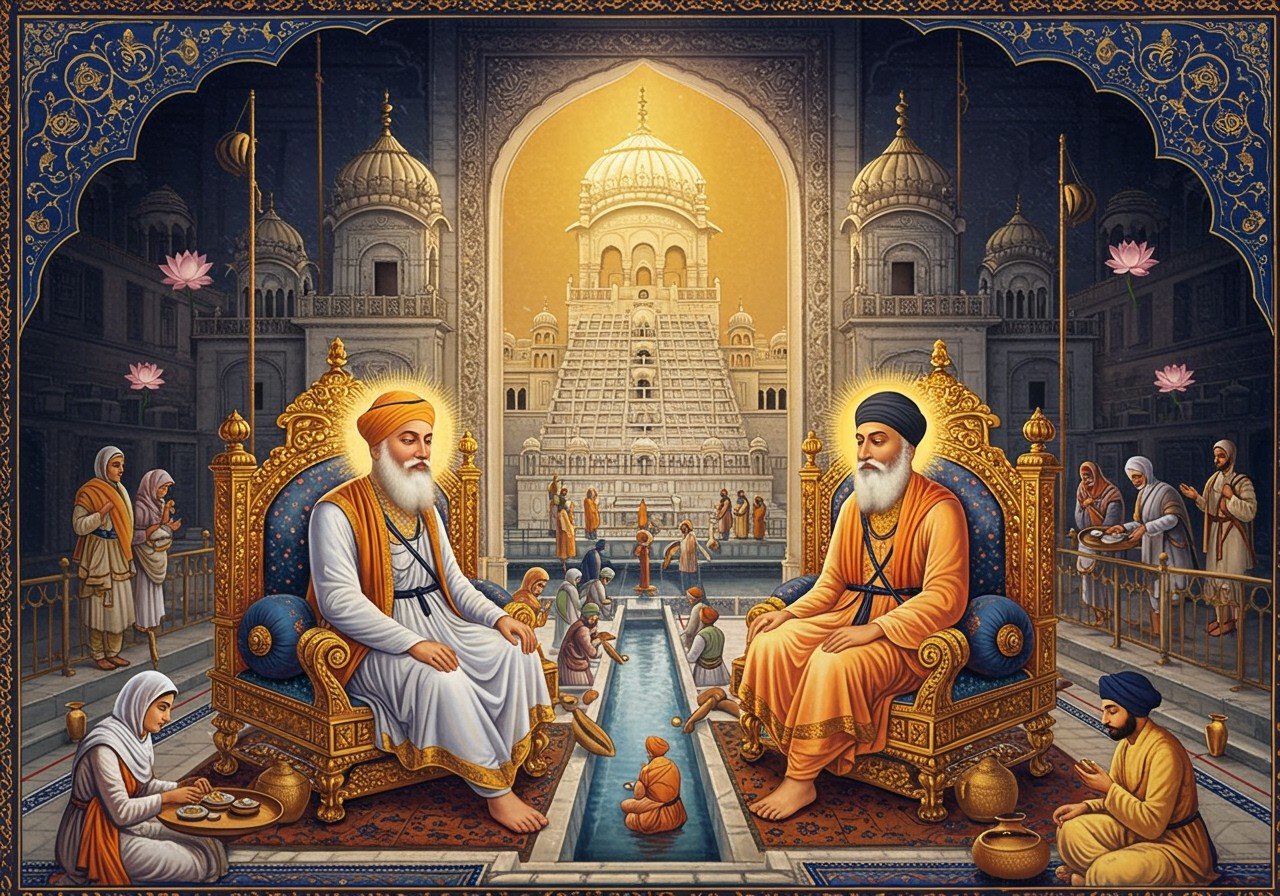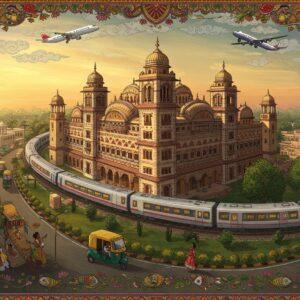
Sikhism, a faith deeply rooted in spiritual wisdom, thrives thanks to the legacy of its revered Gurus. The seamless transition of leadership between them played a crucial role in maintaining the faith’s continuity. Let’s delve into the unique bond and succession between Guru Amar Das Ji and Guru Ram Das Ji, highlighting how spiritual authority is earned through merit and wisdom, not just family ties.
Guru Amar Das Ji: A Beacon of Service and Equality
Guru Amar Das Ji, the third Sikh Guru (1479-1574), significantly shaped Sikhism. He wasn’t born into the faith; his life transformed after a profound encounter with Guru Angad Dev Ji. Embracing Sikhism wholeheartedly, he dedicated himself to selfless service, embodying the spirit of seva.
His most enduring contribution is arguably the Langar, the community kitchen. This simple yet powerful act provides free meals to everyone, regardless of background, fostering a sense of equality and unity before God. Imagine sharing a meal with people from all walks of life, united by the spirit of sharing and devotion – that’s the essence of the Langar. Guru Amar Das Ji also established the Manji system, decentralizing spiritual authority and allowing Sikh teachings to reach wider communities. This foresight ensured the growth and vibrancy of the faith.
A Bond Beyond Blood: Guru Amar Das Ji and Guru Ram Das Ji
Guru Amar Das Ji shared a deep connection with his son-in-law, Guru Ram Das Ji (1534-1581), a bond woven with shared spiritual values. Bhai Jetha, as Guru Ram Das Ji was known before, became a devoted disciple, his dedication unwavering. His marriage to Bibi Bhani Ji, Guru Amar Das Ji’s daughter, strengthened their familial ties, but their relationship transcended the earthly realm. It was a spiritual kinship, a testament to how shared faith can forge connections stronger than blood.
Choosing Wisdom: The Succession of Guru Ram Das Ji
When choosing a successor, Guru Amar Das Ji prioritized spiritual qualities over lineage. He sought humility, devotion, and profound spiritual insight. While he had biological sons, Mohan and Mohri, his choice fell upon Guru Ram Das Ji, the fourth Sikh Guru. This decision underscores the importance of merit in Sikh leadership. Guru Ram Das Ji’s exemplary seva and unwavering devotion made him the natural choice.
The Legacy of Guru Ram Das Ji: Amritsar and Beyond
Guru Ram Das Ji’s contributions are immense. He founded the city of Amritsar, a spiritual sanctuary for Sikhs globally. Today, the Golden Temple stands as a beacon of faith, attracting devotees from all corners of the world. He further strengthened the Langar, reinforcing the principles of equality and humility. He also enriched Sikh spiritual literature with hymns that resonate with love, devotion, and remembrance of the Divine.
A Legacy of Service and Equality
The succession from Guru Amar Das Ji to Guru Ram Das Ji solidified the principle of merit-based spiritual leadership in Sikhism. Their combined legacy promotes social equality, community service, and unwavering devotion. Their lives serve as an inspiration, reminding us of the power of humility and selfless seva.
Honoring the Legacy with Poojn.in
At Poojn.in, we offer a curated selection of items to connect you with the teachings of these revered Gurus. You can find everything you need right here, from brass utensils for Langar seva to beautifully crafted Guru Granth Sahib covers. We also have incense and dhoop to create a sacred atmosphere in your home. Explore our collection today and bring the blessings of these great Gurus into your life.
Here are some items you might find helpful:
- Guru Granth Sahib Covers: Show your reverence with these elegant covers crafted from premium materials. They are designed to protect and honor your scriptures.
- Chaur Sahib: These ceremonial whisks are an integral part of Sikh ceremonies, symbolizing respect and devotion. We offer a variety of styles and materials.
- Prayer Mats: Find comfort and focus during your prayers with our comfortable and durable prayer mats. These mats provide a dedicated space for your spiritual practice.
- Brass Utensils: Use pure brass utensils for Langar seva and other religious ceremonies. Brass is considered auspicious and adds a traditional touch to your rituals.
- Incense and Dhoop: Create a serene and sacred atmosphere with our selection of pure incense and dhoop. These fragrances enhance the spiritual experience.
Shop online at Poojn.in for convenient delivery across India. Need help with a large order or have a specific request? Call us at 03369029784 or WhatsApp us at 9476142738. We’re always happy to assist.
Frequently Asked Questions
What is the connection between Guru Amar Das Ji and Guru Ram Das Ji? Guru Ram Das Ji was Guru Amar Das Ji’s son-in-law, married to his daughter Bibi Bhani. This familial connection deepened through shared spiritual devotion.
Why did Guru Amar Das Ji select Guru Ram Das Ji as his successor? Guru Ram Das Ji’s humility, devotion, and deep understanding of Sikh principles impressed Guru Amar Das Ji. He saw in him the ideal qualities of a spiritual leader, prioritizing these over familial ties.
What are some of Guru Ram Das Ji’s key contributions to Sikhism? He established Amritsar, the spiritual center for Sikhs, and composed hymns now included in the Guru Granth Sahib. His focus on seva (selfless service) further strengthened the Sikh community.
Did Guru Amar Das Ji have other children? Yes, he had two sons, Mohan and Mohri. However, he chose Guru Ram Das Ji based on merit, emphasizing spiritual qualities over bloodline.
What is the broader significance of this succession? The transition from Guru Amar Das Ji to Guru Ram Das Ji reinforces that Sikh leadership is earned through spiritual merit. This sets a precedent for future successions and strengthens the core values of the faith.
How do the legacies of these two Gurus continue to shape Sikhism? Their emphasis on equality, community service (seva), and devotion through the Langar and the establishment of Amritsar continue to inspire Sikhs worldwide.
What were the core principles of Guru Amar Das Ji’s teachings? He championed equality, seva, and devotion, challenging social inequalities and empowering women.


